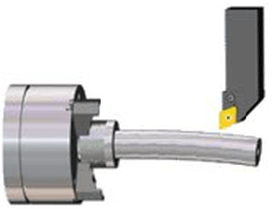CNC lathe work holding – when to use tailstock and steady rest
The part held in the chuck is a cantilever, and the radial cutting force of the tool tends to bend the part. You use a tailstock or steady rest to prevent the bending. Here’s a CNC lathe work holding thumb rule that tells you when you can hold in a chuck, when to use a tailstock, and when to use a steady, based on the L/D (Length to Diameter) ratio of the part.
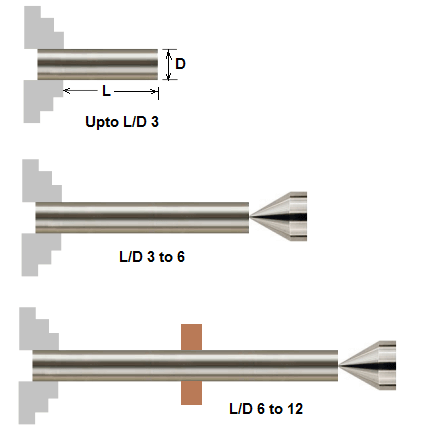
Chuck only: Use if L/D is less than 3. You can go up to L/D 5 with reduced cutting parameters, which reduce the cutting force. Tailstock: Use if L/D is between 3 and 6. You can go up to L/D 10 with reduced cutting parameters. Steady rest: Use if L/D is between 6 and 12. You can go up to L/D 20 with reduced cutting parameters.
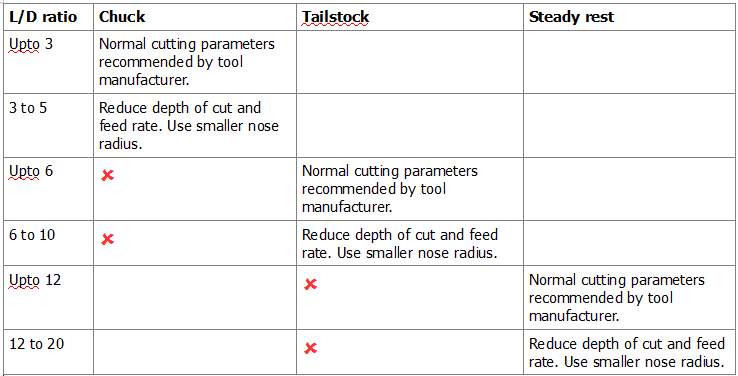
If you want to cut with the full recommended cutting parameters, every 3 L/D requires a new holding point. E.g., A chuck is a single holding point, chuck+tailstock is 2 holding points, chuck+tailstock+steady is 3 holding points, etc. Use this formula to determine the number of holding points: No. of holding points = ((L/D) / 3), rounded off to the next higher number. E.g., L/D 4.5 would require 2 holding points – (4.5/3 ) is 1.5, and this rounded off to the next higher number is 2. If you’re willing to cut with reduced cutting parameters, in this formula change the 3 to 5. Caution A rule of thumb is not the best way to do something. It is not always right. It is just a tool for quick decision making, for figuring out what you can get away with. Text and pics. source: CADEM NCyclopedia multimedia CNC training software.

Etc
Origin of the phrase ‘Rule of Thumb’ (or Thumb rule)
A rule of thumb is a principle with broad application that is not intended to be strictly accurate or reliable for every situation. There are various theories on the origin of the phrase, but the most logical one seems to be the use of the thumb as a rough measure of length. The thumb was also used by brewers to gauge the temperature of fermenting liquor. This rough unit of measurement evolved into a phrase that means a ‘rough principle’.
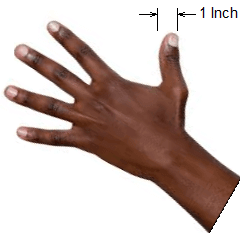
A man’s thumb is roughly an inch wide, and served as a good quick measure of an inch. In fact, in many languages the words for inch and thumb are the same or similar. French, Italian, Czech, Hungarian and Dutch have the same words for inch and thumb: French – pouce for inch and thumb; Italian – pollice for inch and thumb; Czech: palec for inch and thumb, Dutch: duim for inch and thumb. Spanish, Portugese, Swedish and Danish have similar words for inch and thumb. The thumb is not the only human body part to be used as a measure. The human foot (approx. equal to 1 foot) was used as a measure, and so was the arm, from the elbow to the fingertips. Must have been very confusing, with human sizes changing from person to person, country to country. Horses’ heights are still measured in ‘Hands’ in a few countries.
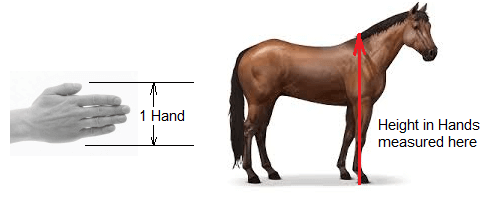
Some rules of thumb (just a few of the thousands in the world) (the first one makes serious sense – I’m going to try it to reduce my paunch ):
1. Most overeating happens at night. If you can’t diet all the time, diet after dark.
2. To calculate the calories you need to maintain your weight, multiply your weight by 15. 3. 3. Count the number of times a cricket chirps in 15 seconds, and add 37. It’ll give you the temperature in degrees Fahrenheit.
4. The African elephant has an ear shaped like Africa, the Indian elephant has an ear shaped like India.
5. When people talk, they stand just far enough apart to reach out and stick their fingers into each other’s ears.
6. Mammals with headgear (antlers, horns, tusks, etc.), are vegetarians.
7. Ducks have orange feet and short necks. Geese have dark feet and longer necks.
